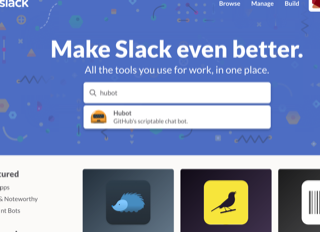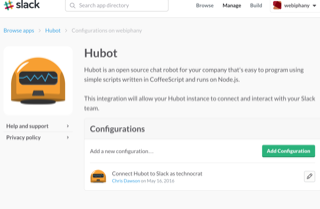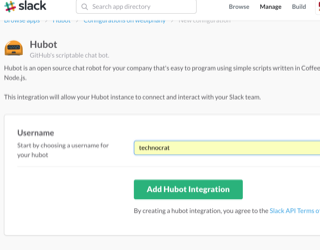Developer in distress? Put out the technocrat signal and get immediate help from a superhero!
- a Hubot with Slack adapter (in coffeescript) that listens for developers in distress!
- a classifier (in Ruby) that uses machine learning to understand which superhero to call!
- an Android app that displays the technocrat signal to the right superhero!
These components teach you about the most important parts of hubot: the Hubot API, the Hubot brain, the HTTP client, and the HTTP server.
To use, install the Docker Toolbox and VirtualBox.
Make sure you are using at least these versions:
$ docker-compose --version
docker-compose version 1.7.0, build 0d7bf73
$ docker-machine --version
docker-machine version 0.7.0, build a650a40
$ docker --version
Docker version 1.11.1, build 5604cbe
Then, run this command to build the playground (in a machine called "technocrat").
$ docker-machine create --driver virtualbox technocrat
$ docker-machine start technocrat
$ git clone https://github.com/xrd/technocrat-signal.git
$ cd technocrat-signal
$ eval $(docker-machine env technocrat)
$ docker-compose build # go get a coffee
First, you need to create a hubot integration inside your slack site.
- Click on the tick under your username inside the Slack browser client (you need to be an admin of the site)
- Search for hubot and choose it when it comes up.
- Create a new configuration
- Add relevant information, like the slackbot username
- Once your bot is up, you need to invite her/him to the channels you want them to participate in.
Then, use the API key below when running these steps.
$ docker-compose run hubot create-hubot myfirsthubot
$ echo 'myfirsthubot' >> hubot/hubots/current-hubot.txt # Tell "docker-compose up" to use this hubot
$ echo 'HUBOT_SLACK_TOKEN=xx-12345' >> hubot/hubots/myfirsthubot/hubot-credentials.txt # establish credentials
$ docker-compose run hubot run-hubot myfirsthubot # start it up without redis backed brain
$ docker-compose run hubot enable-brain myfirsthubot # add [ "hubot-redis-brain" ] to external-scripts.json
$ docker-compose up # start it all with redis turned on and the hubot connected
Jasmine (test runner is bundled) and can be used to run tests for your hubot.
To run tests, create a spec directory and put tests in there. Then, run this command
(using the example withtests application).
$ docker-compose run -w /home/hubot/hubots/withtests hubot jasmine-node --coffee spec/
.
Finished in 0.008 seconds
1 test, 1 assertion, 0 failures, 0 skipped
Or, from inside a one-off container if you want.
$ docker-compose run hubot bash
hubot@6eb956781ea:~# cd hubots/withtests
hubot@6eb956781ea:~# jasmine-node --coffee spec
hhhhhhubot@ff42a4ed1740:~/hubots/withtests$ jasmine-node --coffee spec
.
Finished in 0.008 seconds
1 test, 1 assertion, 0 failures, 0 skipped
See an example of tests in this spec file slack-utils.spec.coffee and the slack-utils.coffee library it tests.
$ docker-machine up
This starts the classifier, and the "current" hubot backed by a redis for persisting the brain.
Now, use the Android app to skip Slack completely.
By default your docker machine will not be accessible to the outside world. You can port forward the Hubot status using a bridged adapter.
Follow these instructions to setup a bridged adapter.
Then, run this command
$ VBoxManage controlvm technocrat natpf1 "hubot,tcp,,8080,,8080"




